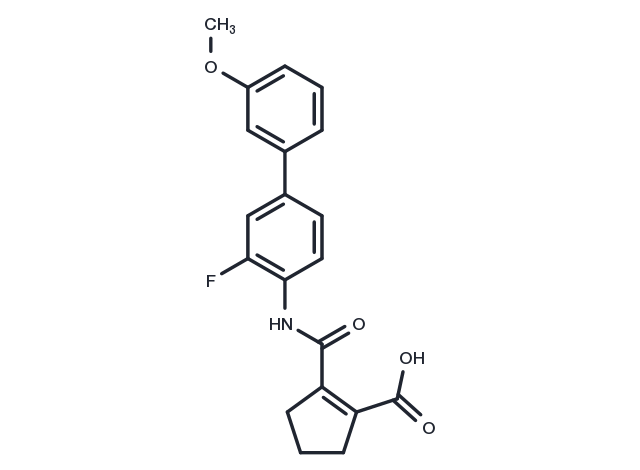Powder: -20°C for 3 years | In solvent: -80°C for 1 year


Vidofludimus (SC12267) (4SC-101, SC12267) is a novel small molecule inhibitor of dihydroorotate dehydrogenase (DHODH).

| Pack Size | Availability | Price/USD | Quantity |
|---|---|---|---|
| 2 mg | In stock | $ 54.00 | |
| 5 mg | In stock | $ 77.00 | |
| 10 mg | In stock | $ 126.00 | |
| 25 mg | In stock | $ 230.00 | |
| 50 mg | In stock | $ 369.00 | |
| 100 mg | In stock | $ 522.00 | |
| 1 mL * 10 mM (in DMSO) | In stock | $ 61.00 |






| Description | Vidofludimus (SC12267) (4SC-101, SC12267) is a novel small molecule inhibitor of dihydroorotate dehydrogenase (DHODH). |
| Targets&IC50 | DHODH (human):134 nM |
| In vitro | Vidofludimus causes a concentration dependent inhibition of phytohemagglutinin-stimulated PBMC proliferation via the inhibition of pyrimidine de novo synthesis. [1] Vidofludimus attenuates IL-17 secretion from colonic strips by inhibition of STAT3 and NF-κB activation. [2] |
| In vivo | In MRLlpr/lpr mice, Vidofludimus (300 mg/kg, p.o.) reduces systemic autoimmunity and improves Lupus Nephritis. [1] In Rats, Vidofludimus (60 mg/kg, p.o.) effectively reduces macroscopic and histological pathology and the numbers of CD3+ T cells. [2] In a rat model of renal transplantation, Vidofludimus (20 mg/kg, p.o.) prolongs survival, paralleled by amelioration of histologic signs of acute rejection. [3] |
| Kinase Assay | DHODH inhibition assay: In vitro DHODH inhibition assay mixture contains 50 μM decycloubiquinone, 100 μM dihydroorotate, and 60 μM 2,6-dichloroindophenol. The amount of enzyme is adjusted such that an average slope of approximately 0.2 AU/min will be achieved in the assay for the positive control (eg, without inhibitor). Measurements are conducted in 50 mM TrisHCl, 150 mM KCl, 0.1% Triton X-100, and pH 8.0 at 30°C in a final volume of 1 ml. The components are mixed, and the reaction is started by adding dihydroorotate. The reaction is followed spectrophotometrically by measuring the decrease in absorption at 600 nm for 2 minutes. The assay is linear in time and enzyme concentration. Inhibitory studies are conducted in a standard assay with additional variable amounts of inhibitor. For the determination of the IC50 values (concentration of inhibitor required for 50% inhibition), eight different inhibitor concentrations are applied. Each data point is recorded in triplicates on a single measurement day. |
| Synonyms | SC12267, 4sc-101 |
| Molecular Weight | 355.36 |
| Formula | C20H18FNO4 |
| CAS No. | 717824-30-1 |
Powder: -20°C for 3 years | In solvent: -80°C for 1 year
H2O: < 1 mg/mL (insoluble or slightly soluble)
DMSO: 100 mg/mL (281.4 mM)
Ethanol: 1 mg/mL (2.81 mM)
You can also refer to dose conversion for different animals. More
bottom
Please see Inhibitor Handling Instructions for more frequently ask questions. Topics include: how to prepare stock solutions, how to store products, and cautions on cell-based assays & animal experiments, etc.
Vidofludimus 717824-30-1 Cell Cycle/Checkpoint DNA Damage/DNA Repair Immunology/Inflammation Metabolism DNA/RNA Synthesis Dehydrogenase Interleukin DHODH SC-12267 fatty liver Inhibitor SC12267 Dihydroorotate Dehydrogenase dihydroorotate dehydrogenase (DHODH) oral 4sc-101 Interleukin Related FXR NR1H4 non-alcoholic fatty liver disease (NAFLD) inflammatory bowel disease (IBD) immunomodulatory farnesoid X receptor (FXR) inhibit SC 12267 inhibitor
